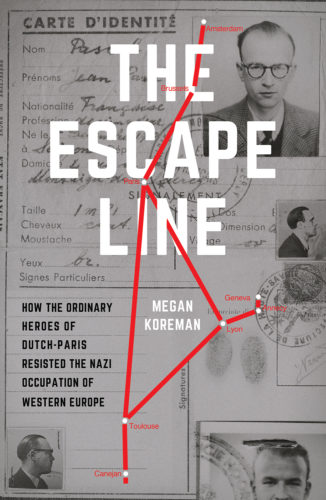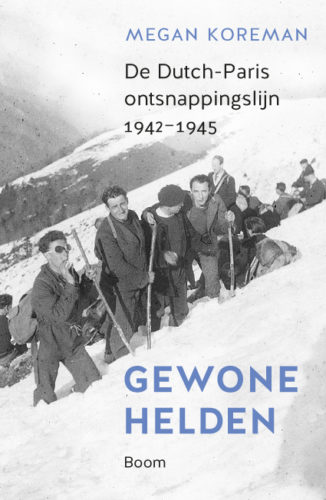Searching for the Dutch-Paris Escape Line
That’s Not the Map of Dutch-Paris
I’ve finally figured out why the map on the first version of the cover for The Escape Line was wrong. I couldn’t understand why the designer had included towns that were not part of Dutch-Paris’s routes. But I had made the mistake of assuming that the designer had based the cover on the photos and maps in the book or even read the book.
Then I saw the small promotional piece that a local librarian posted for a talk I gave in January. There was that same incorrect map. And this time I recognized it because the map was part of a commemorative stamp cover released in the 1980s. I’d seen it before in the Weidner archives and read quite a bit of correspondence about it. The commemorative stamps were part of a gambit of men who had not been part of Dutch-Paris to claim that they were actually the leaders of Dutch-Paris. A scandal ensued in the world of Dutch resisters, leading to the disgrace of the pretenders.
Where on earth, I wondered, Read the rest of this entry »
Bastille Day 1944
Today, July 14, is Bastille Day, the French national holiday celebrating freedom and democracy. It shouldn’t be any surprise that during WWII the Vichy regime banned the celebration of Bastille Day. This created a bit of a conundrum in 1944. In those parts of France that were definitively liberated by July 14, people celebrated publicly and with a lot of verve. In those places where the Germans were still in control, such as Paris, celebrations had to be a lot more circumspect. But what about those parts of the country that had never had much of a German presence or could consider themselves under Resistance control?
Two Dutch-Paris couriers found out just how confused the situation could be. Both men in their early 30s, they had left Switzerland a week earlier to try to find out what was happening with their Dutch-Paris colleagues in Paris and Brussels. They made it to Paris, although they couldn’t find most of the people they were looking for. They gave up trying to Read the rest of this entry »
- 0 Comments
- Tags: France
Arrests after D-Day
Knowing as you do that the Normandy Landings on June 6, 1944, turned out to be a huge success and that the Allies won the Second World War, you would think that the Germans focused all their resources and all their attention on pushing back the Allied advance. This was a lot more true for the German army, the Wehrmacht, than it was for the other German units and authorities occupying France and Belgium.
Eight days after D-Day and 15 weeks after the first round-up of the Dutch-Paris aviator escape line in Paris, German police arrested a young French courier and her mother at their home in a suburb of Paris. Three days later they arrested another Dutch-Paris courier at her apartment in the city. Five days after that Read the rest of this entry »
- 0 Comments
- Tags: arrests, Belgium, France
Escaping to Spain meant trekking over the Pyrenees for at least two days, often at night, often in the snow and always with border guards on your heels. Not surprisingly, Dutch-Paris relied on local men who ran their own escape lines over the mountains to take Dutchmen and aviators the final miles into Spain.
One of these guides, or passeurs, was an escaped French POW known as Charbonnier. He belonged to the local Secret Army and had, in fact, been given the job of regulating clandestine passages over the mountains in that region. He and his network helped very large groups of evaders including both Allied aviators and civilians. Unlike other passeurs, Charbonnier provided an armed escort for his convoys to Spain, at least in certain sections at certain times.
The Germans finally caught him a few days after the Normandy Landings. On June 13, 1944, Charbonnier did not show up at the high mountain huts where a number of fugitives, including Allied aviators and Dutch resisters travelling with Dutch-Paris, were expecting him. He and two of his colleagues were driving up to the huts when the Germans ambushed them on a stone bridge over a narrow but powerful mountain stream. Reports differ about whether they were killed by machine gun or flame thrower, but they most definitely did not survive.
Charbonnier’s network was well enough organized and firmly enough rooted in the local populace that his death caused only a slight delay in the evasion of the fugitives waiting in the huts. They set out two days later and arrived in Spain on 18 June 1944. One of them was a Dutch RAF pilot who had tunneled out of the POW camp at Sagan on 24 March 1944 as part of the “Great Escape” and was only now completing his escape from occupied territory.
- 0 Comments
- Tags: Allied airmen, Pyrenees, Spain
Here’s another example of why historians use footnotes. A few of the people Dutch-Paris helped get into Switzerland were family members of prominent French resisters. They were in danger under the German and Vichy policy of family responsibility, meaning that family members could be held as hostages or punished because of a resister’s actions. Two such fugitives were the 9 and 11 year-old children of the leader of a very large French intelligence network. Dutch-Paris gave them the code name “les enfants de Marie,” or “Marie’s children.”
A fellow historian recently pointed out that in her memoir about her resistance network published in 1968, Marie said that Dutch-Paris gave the children to peasants. These peasants pointed the two children in the direction of the barbed wire fence several miles away on the Swiss border and told them Read the rest of this entry »
Weidner & Colleagues Arrested in Toulouse
Seventy-five years ago tomorrow, on 20 May 1944, Jean Weidner and three other members of Dutch-Paris were arrested outside of a restaurant in Toulouse by French paramilitary collaborators in the Milice. Ironically, it was a case of mistaken identity. Weidner had a price on his head, but they thought they were arresting a French Communist who they wanted in connection to the deaths of several Miliciens.
One of the Dutch-Paris men, the one who lived in Toulouse, fumbled his documents and ran away down the street. The other three were taken to the Milice prison, which was not very far at all from the café that Dutch-Paris used as a headquarters in the city. Two nights later one of them jumped out of Read the rest of this entry »
- 0 Comments
- Tags: arrests, France, John Henry Weidner
Liberation of the Netherlands
Today, May 5, is the 74th anniversary of the liberation of the Netherlands. The Dutch have a big party to celebrate every five years. But every single year they commemorate the war and occupation on May 4 with solemn memorials across the country attended by huge crowds. It’s not that the Dutch weren’t happy or grateful to be liberated. In fact, Dutch families still tend the graves of Allied soldiers who died in the battles to liberate the Netherlands. It’s just that the catastrophe of five years of occupation outweighs the joy of ending that occupation.
The Dutch had a hard war, but none of the military destruction, forced removals, or deportations was as traumatic for the population as whole as the last winter of the war. After the Allies landed in Normandy in June 1944, they pushed on to liberate Paris at the end of August 1944 and Brussels in early September 1944. The Allies continued north into the Netherlands but stopped at the natural barrier of the major rivers that divide the southern third of the country from the northern two-thirds. After the debacle of the failure of Operation Market Garden Read the rest of this entry »
- 0 Comments
- Tags: The Netherlands
Here’s another worry that Weidner and his lieutenants faced as they tried to figure out the extent of the German roll-up of Dutch-Paris in late February 1944. Would the Germans carry out their published threat of punishing the extended families of resisters who helped Allied aviators? After all, they arrested the 14 year-old son of one resister, and the boy later reported that interrogators repeatedly demanded to know where his mother and younger sisters were hiding. They also arrested Weidner’s sister as a hostage.
Weidner tracked down the hiding place of the mother and girls to offer to take them to Switzerland. The mother declined because she Read the rest of this entry »
Continuing our discussion of the fall-out of the wave of arrests in Dutch-Paris in late February 1944, we come to the question of what the survivors should do. The sensible thing would have been to call it a day and scatter into false identities and new hiding places far from Paris, Brussels or Lyon. But they couldn’t do that because too many people were depending on them. There were Jews in hiding places and Allied aviators in safe houses waiting to move onward to Spain. Weidner and his colleagues would not abandon these people, so they kept Dutch-Paris going.
But Jean Weidner did not have to lose another sister to the Germans. One sister, Gabrielle, was sitting in prison as a hostage meant to lure Weidner into giving himself up. But Weidner’s other sister, Annette, was at large in Paris. The Germans Read the rest of this entry »
- 0 Comments
- Tags: arrests, John Henry Weidner, Switzerland, women
What the Survivors Didn’t Know
Seventy-five years ago Jean Weidner and his lieutenants were still trying to figure out just what happened in Paris, Brussels and Lyon at the end of February 1944. With the bird’s eye view of hindsight, we know that German police coordinated raids on several Dutch-Paris addresses on the same morning in Paris and then in Brussels and Lyon two days later. But at the time the resisters had no way of knowing that. They knew that a handful of their colleagues had been arrested and that others were missing. But what had happened to them? Had they been captured? Had they gone even further underground to avoid arrest and just not re-established contact yet?
The question had wider consequences than the fate of one particular individual. If the missing person had gone deeply underground, then he or she was safe, which was a relief. If he or she had been arrested, though, Read the rest of this entry »
- 0 Comments
- Tags: arrests, France

